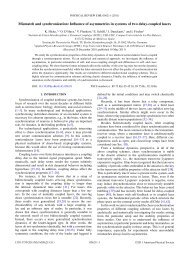CHAPTER 6. SETTING 82But we can perform a T-duality <strong>on</strong> the circular ψ dimensi<strong>on</strong> <str<strong>on</strong>g>of</str<strong>on</strong>g> the trumpet, resultingin the cigar geometry (see Fig. 6.4), and the change <str<strong>on</strong>g>of</str<strong>on</strong>g> our D4-brane to a D5-brane.In factorized terms, our D3-“Minkowski”-brane remains unchainged, but the D1-branein the trumpet geometry now becomes a D2-brane covering the entire cigar geometry.This geometry is given by⎧⎨ds 2 = α ′ k [ dρ 2 + tanh 2 ρ dτ 2] ,⎩e 2Φ = e2Φ 0ch 2 ρ . (6.10)As far as the presence <str<strong>on</strong>g>of</str<strong>on</strong>g> the NS5-<strong>branes</strong> goes in these geometries, <strong>on</strong> the trumpet <strong>on</strong>ecan c<strong>on</strong>sider them to be at infinity <strong>on</strong> the exploding plane at r = 0, and at the origin<strong>on</strong> the cigar.6.4 RoadmapWe have now come to a point where we managed to isolate our test subject in a geometrywe know how to handle. So how should we proceed from here <strong>on</strong>?We cannot simply write down the <str<strong>on</strong>g>DBI</str<strong>on</strong>g> acti<strong>on</strong> for a D-brane in some geometry, aD2-brane in the cigar geometry in our specific case, and start varying around. Whatwe first need to do is to find the classical soluti<strong>on</strong> <str<strong>on</strong>g>of</str<strong>on</strong>g> the D-brane in this geometry.The classical soluti<strong>on</strong> is what <strong>on</strong>e finds when <strong>on</strong>e varies the unperturbed <str<strong>on</strong>g>DBI</str<strong>on</strong>g> D-braneacti<strong>on</strong> with respect to the coordinates or fields <strong>on</strong>e ultimately wants to vary, or moreprecisely can vary. This soluti<strong>on</strong> effectively extremizes the <str<strong>on</strong>g>DBI</str<strong>on</strong>g> acti<strong>on</strong>, thus c<strong>on</strong>stitutingthe equilibrium soluti<strong>on</strong> around which we will want to perturb. As a specific example,c<strong>on</strong>sider a D1-brane in the cigar and trumpet geometries. As will be shown in the nextchapter, the classical soluti<strong>on</strong>s for these c<strong>on</strong>figurati<strong>on</strong>s are given bytrumpet:cigar:sin(ψ − ψ 0 ) = Cchρ , (6.11)sin (τ − τ 0 ) = Cshρ . (6.12)Minimizing the energy <str<strong>on</strong>g>of</str<strong>on</strong>g> the D-brane in these c<strong>on</strong>figurati<strong>on</strong>s, these equati<strong>on</strong>s also tell ushow the brane will positi<strong>on</strong> itself in these geometries, i.e. they represent the embeddings<str<strong>on</strong>g>of</str<strong>on</strong>g> the D-brane in the geometry. In these embeddings, we see the appearance <str<strong>on</strong>g>of</str<strong>on</strong>g> twointegrati<strong>on</strong> c<strong>on</strong>stants, C and ψ 0 and τ 0 for the trumpet and cigar respectively. ψ 0 andτ 0 are angles with no physical interpretati<strong>on</strong>; they simply define an <str<strong>on</strong>g>of</str<strong>on</strong>g>fset compared tothe origin in that directi<strong>on</strong>, which amounts to rotating the brane around geometriesthat are symmetrical in that directi<strong>on</strong>, hence not changing the physics. The c<strong>on</strong>stant Chowever has a very distinct interpretati<strong>on</strong>: it can be c<strong>on</strong>sidered as a measure <str<strong>on</strong>g>of</str<strong>on</strong>g> distance<str<strong>on</strong>g>of</str<strong>on</strong>g> the D1-brane to the NS5-ring, as is shown in Figure 6.5.Once we have found the classical soluti<strong>on</strong>, we can start thinking about varying theacti<strong>on</strong>. For this, <strong>on</strong>e simply introduces perturbati<strong>on</strong>s <str<strong>on</strong>g>of</str<strong>on</strong>g> coordinates and/or fields (e.g.the Maxwell field living <strong>on</strong> the D-brane). These perturbati<strong>on</strong>s will enter the acti<strong>on</strong>
CHAPTER 6. SETTING 83through the induced metric, Kalb-Ram<strong>on</strong>d field and Maxwell field strength, these lasttwo <str<strong>on</strong>g>of</str<strong>on</strong>g> course <strong>on</strong>ly if present. Specifically, given the general pullback form,T αβ = ∂Xµ∂X α ∂X ν∂X β T µν, (6.13)with T µν some arbitrary tensor, partial derivatives <str<strong>on</strong>g>of</str<strong>on</strong>g> the perturbati<strong>on</strong>s will appear. Assuch, when <strong>on</strong>e computes the determinant <str<strong>on</strong>g>of</str<strong>on</strong>g> the resulting matrix (recall the general√−gαβ + B αβ + 2πα ′ F αβ term in the <str<strong>on</strong>g>DBI</str<strong>on</strong>g> acti<strong>on</strong>), and expands the square root, <strong>on</strong>eis typically left with a number <str<strong>on</strong>g>of</str<strong>on</strong>g> zero, first and sec<strong>on</strong>d order partial derivatives <str<strong>on</strong>g>of</str<strong>on</strong>g> theexpansi<strong>on</strong>s. By computing the equati<strong>on</strong>s <str<strong>on</strong>g>of</str<strong>on</strong>g> moti<strong>on</strong> <str<strong>on</strong>g>of</str<strong>on</strong>g> this Lagrangian density, <strong>on</strong>eobtains a differential equati<strong>on</strong> for the perturbati<strong>on</strong>s. By solving this equati<strong>on</strong>, <strong>on</strong>e cananalyse the spectrum <str<strong>on</strong>g>of</str<strong>on</strong>g> the perturbati<strong>on</strong>s.Summarized in short, to obtain the spectrum <str<strong>on</strong>g>of</str<strong>on</strong>g> the perturbati<strong>on</strong>s <str<strong>on</strong>g>of</str<strong>on</strong>g> a D-brane usingthe <str<strong>on</strong>g>DBI</str<strong>on</strong>g> acti<strong>on</strong>, and hence <str<strong>on</strong>g>of</str<strong>on</strong>g> the low-energy excitati<strong>on</strong>s <str<strong>on</strong>g>of</str<strong>on</strong>g> the D-brane, <strong>on</strong>e shouldfirst write down the <str<strong>on</strong>g>DBI</str<strong>on</strong>g> acti<strong>on</strong> for the D-brane in the geometry under c<strong>on</strong>siderati<strong>on</strong>,compute the classical soluti<strong>on</strong>, introduce perturbati<strong>on</strong>s, compute the equati<strong>on</strong>s <str<strong>on</strong>g>of</str<strong>on</strong>g> moti<strong>on</strong><str<strong>on</strong>g>of</str<strong>on</strong>g> these perturbati<strong>on</strong>s, and combine them into a differential equati<strong>on</strong>. The soluti<strong>on</strong>s <str<strong>on</strong>g>of</str<strong>on</strong>g>this differential equati<strong>on</strong> tells you the spectrum <str<strong>on</strong>g>of</str<strong>on</strong>g> the perturbati<strong>on</strong>s.6.5 How to recognize bound statesThe last questi<strong>on</strong> left to answer is how to known whether or not the spectrum c<strong>on</strong>tainsbound states.The crucial point is that in order to solve the equati<strong>on</strong>s <str<strong>on</strong>g>of</str<strong>on</strong>g> moti<strong>on</strong> for the perturbati<strong>on</strong>s,<strong>on</strong>e always proposes a factorized soluti<strong>on</strong> c<strong>on</strong>taining a quantum mechanical e iEtterm to remove the always present ∂ 2 t term. This term is always present, because theperturbati<strong>on</strong>s are always c<strong>on</strong>sidered to be time dependent, which by virtue <str<strong>on</strong>g>of</str<strong>on</strong>g> the pullbackmechanism amounts to such a sec<strong>on</strong>d time derivative. This introduces the energy<str<strong>on</strong>g>of</str<strong>on</strong>g> the fluctuati<strong>on</strong>s in the differential equati<strong>on</strong>.Using E 2 = m 2 + p 2 , we can relate this energy to the mass <str<strong>on</strong>g>of</str<strong>on</strong>g> the particles. If <strong>on</strong>emanages to solve the differential equati<strong>on</strong>s resulting from the equati<strong>on</strong>s <str<strong>on</strong>g>of</str<strong>on</strong>g> moti<strong>on</strong>, <strong>on</strong>ecan also derive which values <str<strong>on</strong>g>of</str<strong>on</strong>g> E 2 are allowed by the soluti<strong>on</strong>. A priori, if nothingbounds the particles, this energy is arbitrary since nothing bounds their impulse, i.e.p ∈ [0, +∞[, resulting in a c<strong>on</strong>tinuous spectrum. However, for a bound state p = 0, andso the small mass (E 2 = m 2 ) <str<strong>on</strong>g>of</str<strong>on</strong>g> the particle will reveal itself through a discrete value <str<strong>on</strong>g>of</str<strong>on</strong>g>the energy laying below the c<strong>on</strong>tinuum spectrum.
















